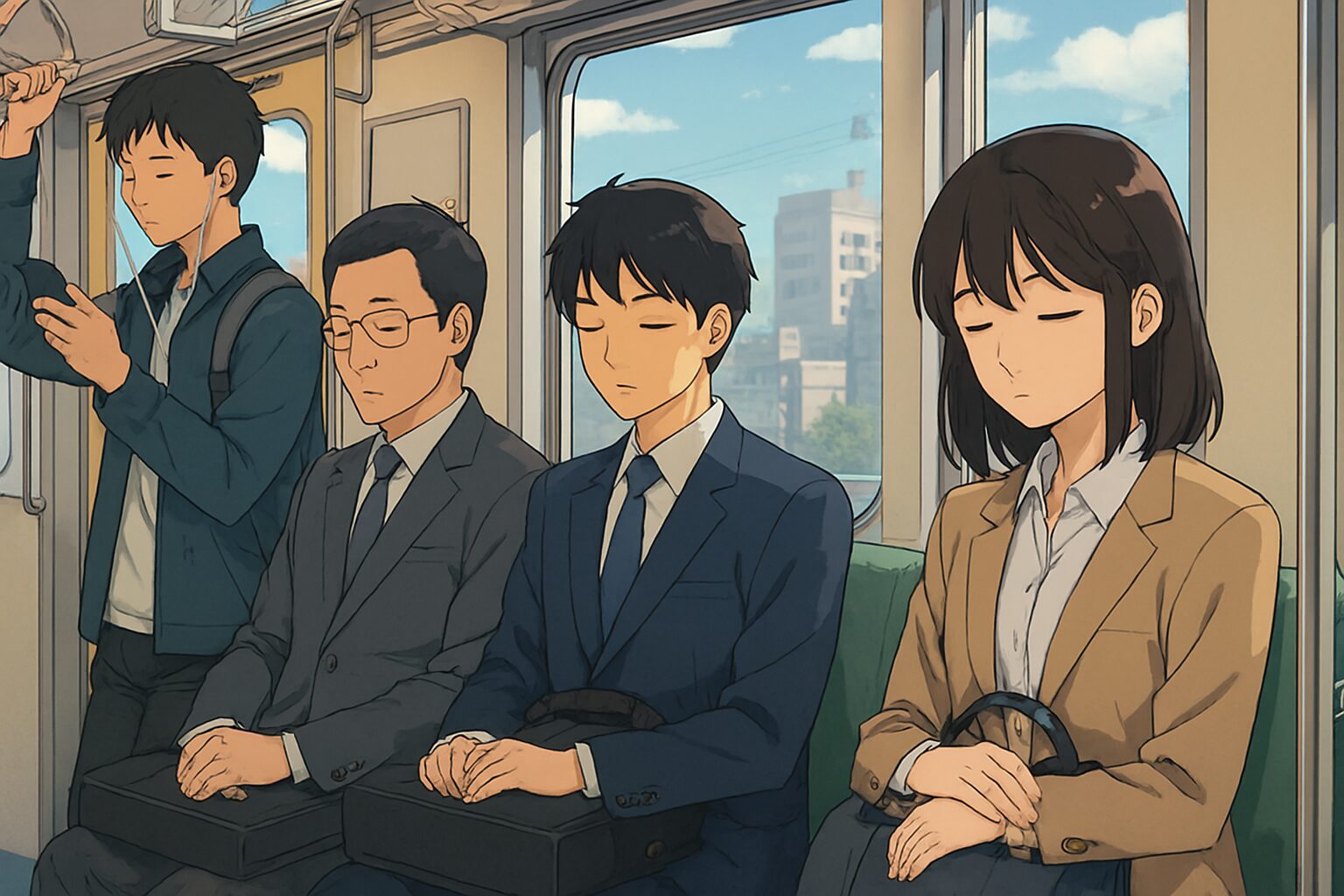If you’ve ever taken a train in Japan, you may have experienced something quietly astonishing: the near-total absence of noise. No loud phone calls. No boisterous conversations. No music leaking from headphones. Just the gentle hum of the train and the occasional polite announcement.
To many overseas visitors, this silence feels surreal. In cities like New York, London, or Paris, public transportation is often a cacophony of voices, sounds, and movement. So why are Japanese trains so quiet—and what does this say about the culture?
Let’s take a deep dive into the social, historical, and philosophical roots of Japan’s famously tranquil trains.
- 🧘♂️ Chapter 1: Silence as Social Courtesy
- 🏯 Chapter 2: Historical Roots of Quiet Conduct
- 📱 Chapter 3: The Role of Technology and Manners
- 🚉 Chapter 4: The Queue as a Silent Choreography
- 🌏 Chapter 5: Global Comparisons—What Makes Japan Different?
- 🎭 Chapter 6: Silence as Aesthetic and Emotional Depth
- 🖼️ Chapter 7: What We Can Learn from Japan’s Quiet Trains
- 🧘♂️ 第1章:沈黙は最大の礼儀
- 🏯 第2章:静けさの歴史的背景
- 📱 第3章:テクノロジーとマナーの共存
- 🚉 第4章:静かな列の美しさ
- 🌏 第5章:世界との違い
- 🎭 第6章:沈黙の美と感情の深さ
- 🖼️ 第7章:静かな電車が教えてくれること
🧘♂️ Chapter 1: Silence as Social Courtesy
In Japan, silence is not just the absence of sound—it’s a form of respect. The cultural concept of rei (礼), often translated as “courtesy” or “etiquette,” permeates everyday life. On trains, this manifests as a collective effort to avoid disturbing others.
People speak in hushed tones, if at all. Mobile phones are set to silent mode. Even children are gently encouraged to keep their voices down. This isn’t enforced by law—it’s guided by a shared understanding of social harmony.
This quiet behavior is part of a broader cultural rhythm, one that values ma (間)—the space between things. Ma is not just physical space, but emotional and temporal space. It’s about knowing when to pause, when to speak, and when to simply coexist without intrusion.
For a deeper exploration of how rei and ma shape Japanese communication, check out The Aesthetics of Silence.
🏯 Chapter 2: Historical Roots of Quiet Conduct
Japan’s emphasis on quietness and order has deep historical roots. During the Edo period, samurai were trained not only in martial arts but also in etiquette. Causing meiwaku (迷惑)—trouble or inconvenience to others—was considered dishonorable.
This ethos continues today. From a young age, children are taught to clean their classrooms, serve lunch to classmates, and wait their turn. These practices instill a sense of shared responsibility and mutual respect.
In public spaces like trains, this translates into a kind of wordless empathy—a collective awareness of others’ needs. People sense each other’s presence, adjust their behavior, and maintain harmony—all without speaking.
📱 Chapter 3: The Role of Technology and Manners
Japan is one of the most technologically advanced countries in the world, yet it maintains strict social norms around tech usage in public. On trains, phone calls are discouraged. Texting and browsing are fine, but always discreet.
Even the sound of headphones is considered intrusive. Many commuters use noise-canceling earbuds not to block out others, but to avoid disturbing them.
This behavior reflects a cultural preference for non-imposing kindness—a way of being considerate without drawing attention to oneself.
🚉 Chapter 4: The Queue as a Silent Choreography
Before boarding a train, passengers form orderly lines—often without any signage or staff direction. They wait patiently, even in the shade of a pillar, respecting each other’s space.
This phenomenon is beautifully explored in Why Do Japanese People Line Up So Quietly?, which describes how even invisible queues reflect a deeper cultural rhythm of empathy and aesthetics.
In Japan, lining up is not just about efficiency—it’s about beauty. It’s a quiet choreography of mutual respect.
🌏 Chapter 5: Global Comparisons—What Makes Japan Different?
In many countries, public transportation is noisy and chaotic. Rules are enforced by staff, signs, or announcements. In Japan, the rules are internalized.
This difference stems from cultural values. Japan emphasizes group harmony (wa 和) over individual expression. The goal is not to assert oneself, but to blend in gracefully.
That’s not to say one system is better than the other. But Japan’s approach offers a compelling alternative: a society where order is maintained not by force, but by shared understanding.
🎭 Chapter 6: Silence as Aesthetic and Emotional Depth
There’s something poetic about the quietness of Japanese trains. It reflects a cultural preference for restraint over display, presence over performance.
In Japanese art and architecture, silence and shadow are celebrated. The classic essay In Praise of Shadows by Jun’ichirō Tanizaki explores how subtlety creates beauty. In the same way, the silence of a train ride becomes a canvas for reflection.
To sit quietly on a train in Japan is to participate in a collective meditation. It’s a moment of stillness in a fast-moving world.
🖼️ Chapter 7: What We Can Learn from Japan’s Quiet Trains
Japanese trains aren’t quiet because people are told to be quiet. They’re quiet because people care—about others, about space, about harmony.
In a world that often feels loud and chaotic, Japan’s silent trains offer a lesson in empathy. They remind us that silence can be meaningful, that order can be beautiful, and that even the smallest actions can reflect deep cultural values.
So next time you ride a train in Japan, take a moment to appreciate the quiet. It’s not just silence—it’s philosophy in motion.
🏷️ Suggested Tags
- Japanese Culture
- Train Etiquette
- Rei
- Ma
- Empathy
- Social Harmony
- Why Japan Series
- Quietness
- Public Transportation
- Cultural Philosophy
🚆 なぜ日本の電車はこんなにも静かなのか?
礼儀・共感・沈黙の美学をめぐる旅
日本の電車に乗ったことがある方なら、一度は驚いたことがあるかもしれません。車内が、驚くほど静かだということに。大声の会話も、電話の着信音も、音漏れする音楽もほとんど聞こえません。あるのは、車両の揺れと、丁寧なアナウンスの声だけ。
ニューヨーク、ロンドン、パリなどの都市では、公共交通機関はしばしば騒がしく、ざわめきに満ちています。それに比べて、日本の電車の静けさは、まるで異世界のようです。
なぜ日本では、電車の中がこんなにも静かなのでしょうか?その背景には、社会的・歴史的・哲学的な理由が複雑に絡み合っています。今回は、その静寂の文化を深く掘り下げてみましょう。
🧘♂️ 第1章:沈黙は最大の礼儀
日本では、沈黙は単なる「音のない状態」ではありません。それは、相手への敬意の表れです。礼(れい)という概念は、日常のあらゆる場面に浸透しており、電車の中では「他人に迷惑をかけない」という形で現れます。
乗客は小声で話し、スマートフォンはマナーモードに設定され、子どもたちも自然と静かに過ごします。これは法律で定められているわけではなく、社会全体の「空気を読む」文化によって支えられています。
この静けさは、間(ま)という美意識にも通じます。間とは、物理的な空間だけでなく、感情や時間の「余白」を意味します。話すべき時、黙るべき時を見極める感性が、日本人の行動に深く根付いているのです。
この「礼」と「間」が日本の無言のコミュニケーションをどう形づくっているかについては、沈黙の美学:礼と間が育む日本の無言のコミュニケーションをご覧ください。
🏯 第2章:静けさの歴史的背景
日本の「静けさ」や「秩序」へのこだわりは、江戸時代にまでさかのぼります。武士は武道だけでなく、礼儀作法も重んじました。他人に迷惑(めいわく)をかけることは、恥とされていたのです。
現代でもその精神は受け継がれています。子どもたちは教室を掃除し、給食を配膳し、順番を守ることを学びます。こうした教育が、公共空間での「見えない思いやり」を育てているのです。
電車の中では、言葉を交わさずとも、互いの存在を感じ取り、自然と行動を調整する。これこそが、日本的な無言の共感なのです。
📱 第3章:テクノロジーとマナーの共存
日本は世界でも有数のテクノロジー先進国ですが、公共空間ではその使い方に厳しいマナーがあります。電車内での通話は控えられ、スマホ操作も控えめに行われます。
イヤホンの音漏れすら気にされるほどの配慮。ノイズキャンセリング機能は、他人のために使われることもあるのです。
これは目立たない優しさの文化。自分の存在を主張するのではなく、そっと周囲に溶け込むことが美徳とされているのです。
🚉 第4章:静かな列の美しさ
電車に乗る前、乗客たちは自然と整列します。案内がなくても、誰もが黙って順番を守ります。柱の陰に並ぶ人も、誰かの後ろにそっと立つ人も、そこには見えない秩序があります。
この現象については、なぜ日本人は静かに並ぶのか?で詳しく紹介されています。列に並ぶという行為すら、日本では美意識の一部なのです。
効率だけでなく、互いを思いやる静かな所作。それが、日本の列の美しさです。
🌏 第5章:世界との違い
多くの国では、公共交通機関は騒がしく、ルールはスタッフや掲示によって守られます。日本では、それが内面化されているのです。
その背景には、「和(わ)」という価値観があります。個人の主張よりも、集団の調和を重んじる文化。目立つことより、馴染むことが尊ばれるのです。
どちらが優れているという話ではありません。しかし、日本の静かな電車は、「強制ではなく共感によって秩序が保たれる社会」の可能性を示してくれます。
🎭 第6章:沈黙の美と感情の深さ
日本の電車の静けさには、どこか詩的な美しさがあります。抑制の美、存在の静けさがそこにあります。
日本の芸術や建築では、沈黙や陰影が称賛されます。谷崎潤一郎の『陰翳礼讃』では、控えめな美がいかに深い感動を生むかが語られています。
電車の中で静かに座ることは、まるで集団瞑想のよう。忙しい日常の中で、ほんのひとときの静寂を味わう時間なのです。
🖼️ 第7章:静かな電車が教えてくれること
日本の電車が静かなのは、誰かに「静かにしなさい」と言われたからではありません。他人を思いやる気持ちが、自然とその空間を作っているのです。
騒がしく、慌ただしい世界の中で、日本の電車は共感のレッスンを与えてくれます。沈黙には意味がある。秩序には美がある。小さな行動にも、深い文化が宿っている。
次に日本の電車に乗るときは、ぜひその静けさに耳を澄ませてみてください。それはただの沈黙ではなく、哲学が走る音なのです。



コメント